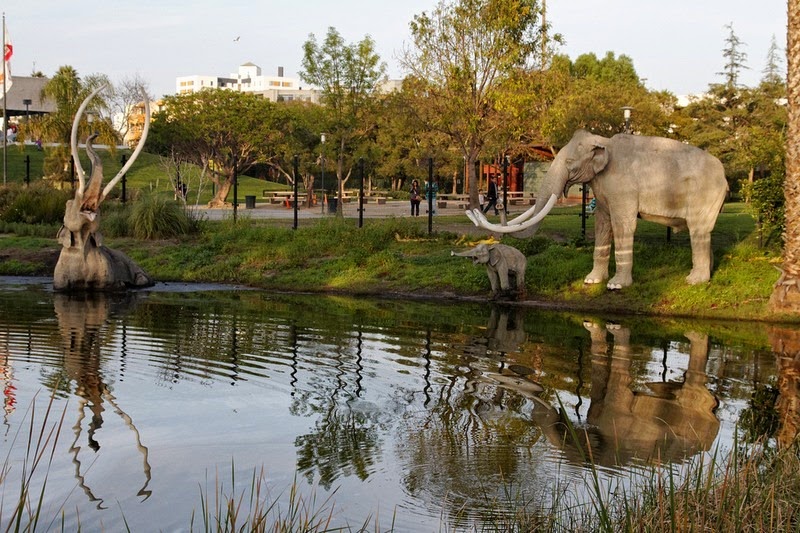The La Brea Tar Pits are a group of tar pits in urban Los Angeles, around which Hancock Park was formed. The pits are one of the world's best and most important sources of Ice Age fossils.
Tar pits form when crude oil seeps to the surface through fissures in the Earth's crust, and when the light fraction of the oil evaporates it leaves behind the heavy tar or asphalt, in sticky pools. The La Brea tar pits have been seeping for tens of thousands of years, and has been traditionally used by local native Americans as glue and as waterproof caulking for baskets and canoes. But for the animals, these tar pits meant death. Over many centuries, hundreds of animals have fallen into the pits, become trapped and lost their lives, but the sticky gooey mass has preserved their bones. Many of these animals are now extinct, so the bones and fossils recovered from the La Brea tar pits are priceless today.
Asphalt or tar is thick and at many times the surface of the pits would be covered with layers of water, dust, or leaves. Animals mistaking it to be solid ground would wander in, become trapped, and eventually die. Predators would enter to eat the trapped animals and also succumb to it. As the bones of the dead animals sink into the asphalt, it soaks into them. The lighter fractions of petroleum evaporate away leaving a more solid substance, which encases the bones.
The bones occasionally found in the tar were first thought to be those of unlucky cattle. It was not until 1901 that the first scientific excavation of the pits were carried out. The pits have, till now, yielded entire skeleton of large mammals such as mammoths and saber-tooth cats. Over the hundred years of digging, some 5.5 million bones were recovered representing more than 600 species of animals and plants - the richest cache of Ice Age fossils. Also recovered are ancient wood and plant remnants, rodent bones, insects, mollusks, dust, seeds, leaves, and even pollen grains. The oldest known material extracted from the La Brea seeps has been dated to 38,000 years old.
Examples of some of these fossils are on display in the George C Page Museum, right next door to the tar pits themselves.

On-going excavation at La Brea Tar Pits. Photo credit
Skeleton of a mammoth at the George C Page Museum. Photo credit
Skeleton of an ancient horse the George C Page Museum. Photo credit
A detail from the frieze above the front entrance to the Page Museum at the La Brea Tar Pits. Photo credit
Sources: Wikipedia / University of Berkeley



















Comments
Post a Comment